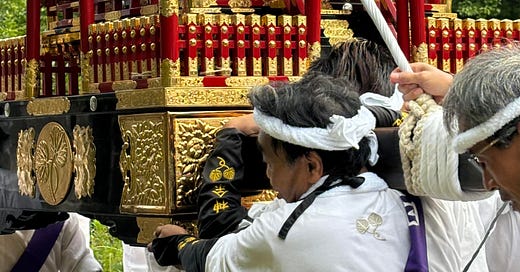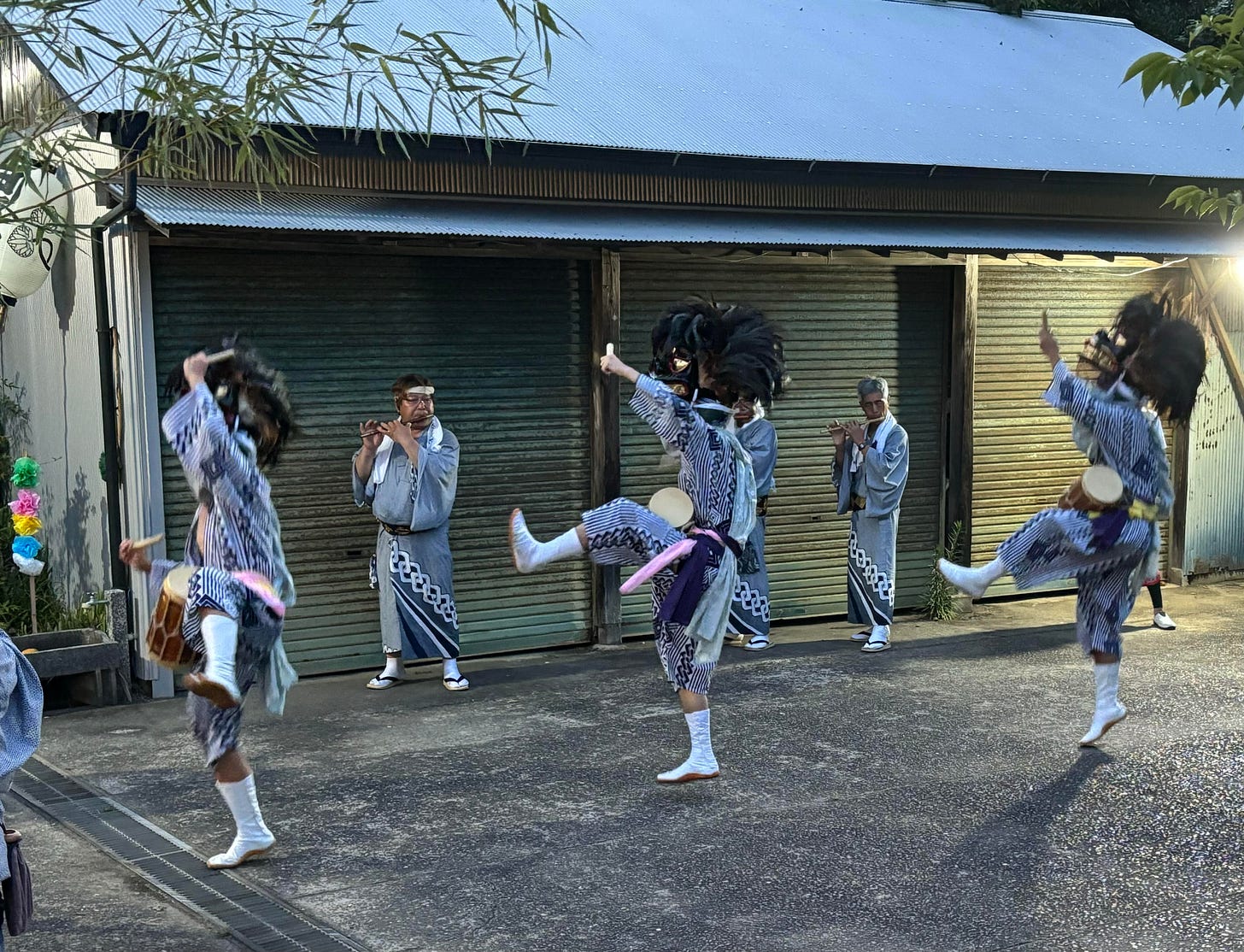The most exciting two days of the year have just come and gone at Frog’s Glen. It’s o-matsuri time!
Lord only knows why the people of this valley centuries ago chose to hold their matsuri, or annual festival, in mid-July. The weather now across the entire country is Steam Bath, and much of a Japanese festival involves exertion, dancing, drinking, and running around…almost all of which occurs outdoor.
And while this valley luxuriates in cool ocean breezes the other 300 days of the year, some village genius seven centuries ago decided our festival would forever more be in July! A month so hot and wet the stone walls start to sweat.
As with so much in Japan, matsuri draws largely from agriculture and agri-religion (i.e., Shinto). Think of it as the time of year when farmers pray for bountiful harvests, less pests, no blights, and if all goes to plan a bit more coin.
Every city, town, and village has a matsuri, and each shares a bit of look and feel, but each locale also sprinkles plenty of its own customs into its rites.
Matsuri I’ve been privileged to attend to date have been parties. Vendors come to set up tents and grills, and everything from fish and meats, noodles, and finger foods are whipped up fresh. There are kiddie games—a particular popular one nationwide is catch and take home goldfish (but you have to use a tissue paper scoop), as well as shoot the toy, toss the rings, and lob the plastic balls at floating prizes. Handicrafts are sold, music is played, the adults drink (often way too much), and everyone gets a bit crazy with all the fun.
Frog’s Glen had precisely none of this.
Toru comes from a less urban part of Japan than Tokyo (he hates when I say that), but still a sizeable city. So he knows many versions of matsuri from his region. But even he was surprised by how “bumpkin” (his word) the Frog’s Glen version turned out to be.
We learned that though we are only 90 minutes away from the concrete sprawl of Tokyo and many hundreds of matsuri kicking up the jam there in a myriad of ways, Frog’s Glen has been cut off so fully—from even other Japanese—it is still doing a festival planned and structured back in about 1400.
Our matsuri celebrates a 600-year-old shrine called Hiyoshi. It’s just across the small highway and up an incredibly steep hill from the Glen. I rarely visit, as it is reached only by an almost 90-degree uphill staircase of at least 150 tall-ass steps. (Come to think of it, the founders of this shrine didn’t just situate it on a hill. They intentionally put it at the top of a sheer rock face no one under the age of 40 could ever reach, and if that wasn’t enough, buried it way up there deep inside a thick stand of pine trees.)
Hiyoshi was built to never be found.
Most of our activities for the two days center around a 1.5-ton portable shrine, or omikoshi, that is carried around the Glen’s rice paddies and paths so it passes in front of most farmers’ houses. Inside the omikoshi are the gods that normally reside at Hiyoshi on the rock face. The men (only men btw) who carry the omikoshi around on their shoulders shake and jostle and perilously dip and swoop the heavy structure as they chant and sing.
Terashima-kun the whippet really didn’t like all the jostling and yelling. I told him, “Don’t worry boy. The farmers are just shaking the Good Juju box.”
The idea with the action and racket is to wake up the gods inside the omikoshi so they pay attention to the village. The harder the men work, the more focused and determined the deities become.
Side note and important word-to-the-wise for foreigners, particularly if you are taller than the average Japanese. If you are ever invited to join one of these omikoshi crews do NOT say yes. Just politely say you are crippled or something. Your above-average height means the entire 1.5 tons of portable shrine weight will now rest on your one shoulder alone.
The locals know this, but will never tell you.
Yes, the Japanese in the crew love when a tall foreigner agrees to join, as their jobs magically become a five-star holiday cruise for the rest of the afternoon. With the extra 3 or 4 centimeters of vertical gap your height has now created for them, they basically swing and hang from the omikoshi poles, drunk and laughing, as you take over everyone’s job.
Anyway, the omikoshi travels around the village, everyone sweats, bystanders clap in support, captains in the crew use megaphones to bark commands and sing songs, rice gets blessed, all that. On the second day of our matsuri, a much smaller “child size” omikoshi comes through the same route. Kids from the local elementary school carry the shrine but of course aren’t put through nearly the same physical paces of shaking, jostling, spinning, and dipping. The boys and girls just carry the lightweight omikoshi and sing songs. The parents walk alongside telling their offspring what a great job they’re doing.
I get the distinct impression that no child is allowed to decline this duty. I can imagine the teachers and parents nipping that crap right in the bud: “You want to let down all your friends who ARE participating?”
“You want a blight to hit daddy’s rice??!!”
So for the two days of matsuri we saw no food, drink, or games, but plenty of rites and religion. One part of the celebration that I did enjoy came on the last night.
Three male dancers dressed in yukata as well as full-face wild boar masks performed “Kakko Mai,” a long and dramatic dance celebrating the inoshishi pigs that scrounge around our hills. The young men beat drums in time with their steps, and a small troupe of older men played bamboo flutes rather well.
If I was the organizer of the Frog’s Glen matsuri this would’ve been the point we roll out five piping grills heaped with smoking inoshishi steaks. But that’s just me.
How is the matsuri party funded? It isn’t the shrine that pays. Every small town, glen, and corner of Japan has an informal quarterly tax that they call Local Council Fee. A guy comes knocking on each person’s door asking for the payment. When you inquire what the tax is used for there is some mumbling about garbage, leaves, signs, and “all that management kind of thing.”
I’ll clue you in. The Local Council Fee actually is a Party Pot. And the matsuri is when it mostly gets spent. Magically during the festival, each site the portable omikoshi shrine stops for a rest rolls out trays of ice-cold beers, sakes, and juices, as well as platters of meats, fish, sushi, and more. Chips and cookies for the kids too. In the evening, the partying continues as each neighborhood holds so-called Communication Events, which are really just sit-down feasts with drinking for the grown-ups.
I think it’s a great system—quite communal—but probably newbies like Toru and I, who pay the tax every quarter, ought to be invited too.
Whoops, we weren’t!
Last night, we did get to enjoy the sounds of singing and drums beating from the village community centers as our tax helped to fuel the food and drink of everyone born in the Glen. Oh well.
Toru looked at the lit community center last night with each of our neighbors pouring beer and passing around sushi plates. “I wouldn’t want to go in any case,” he said. “Would you?”
The truth was indeed I would.










Ouch! You just reminded me of the time, many years ago, when we went to the huge Tenno-sai in Minami Senju. My wife's friend's father was among the organizers and as a favor, they let me take part in the portable shrine thing - luckily, a side event and a smaller omikoshi, because the real thing is a monster.
In vain, I tried to avoid the torture... To this day, my right shoulder is a couple of centimeters lover than the left one.
"...they basically swing and hang from the omikoshi poles, drunk and laughing, as you take over everyone’s job." Hahaha.
How come foreigners can attend but you and Toru can't?